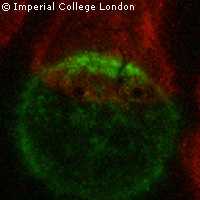Study sheds light on natural killer cells' modus operandi
European researchers have worked out how 'natural killer' immune cells determine whether a cell is diseased, and so needs to be destroyed, or healthy, in which case it can be left alone. The findings, published in the journal PLoS (Public Library of Science) Biology, could lead to the development of new ways to boost the activity of these cells and treat diseases. Natural killer (NK) cells are white blood cells and, with over 1,000 NK cells in every drop of blood, they are major players in the body's innate immune system. The NK cells patrol the body, providing the front line of defence against tumours as well as viral and bacterial infections. When they latch onto a diseased cell, the NK cells direct toxic granules towards the target cell. However, during their voyage around the body, the NK cells also regularly latch onto perfectly healthy cells, before detaching themselves and moving on, leaving the non-diseased cell unharmed. Until now, it was unclear how the NK cells are able to determine whether a cell is healthy or not. In this study, scientists from Germany, France, the Netherlands and the UK used high-speed microscopy to observe the NK cell decision-making process. Their investigations revealed that the key to the decision is the interaction between proteins on the surface of the NK cell and proteins on the surface of the target cell. 'Scientists have known for a long time that the proteins on the surface on natural killer cells are involved in answering the 'to kill or not to kill?' question, but we've not known exactly how these molecular cues are translated into the correct response,' commented Professor Dan Davis from Imperial College London in the UK. 'Our research has shown that information gleaned from its surface receptors tells the natural killer cell whether to stop patrolling and commence killing, or to move off quickly, and harmlessly, in search of another target.' Every NK cell has two types of receptor on its surface: 'activators' which, as their name suggests, activate the 'kill' response; and inhibitors, which switch the killing mechanism off. When an NK cell attaches itself to a cell that is cancerous or infected, large numbers of activating receptors are triggered. When this happens, the NK cell spreads itself out over the surface of the target cell, continuously monitoring the levels of activating and inhibiting signals as it does so. If activating signals continue to dominate, the NK cell keeps hold of the target cell and eventually kills it. In contrast, healthy cells interact with more inhibiting receptors and relatively few activating receptors. As a result, 'off' signals dominate, and the NK cell soon releases the healthy cell and continues its hunt for diseased cells. 'Considering that NK cells play such an important part in our immune response to cancer and disease, relatively little is known about their functionality - how exactly they work and how they interact with the cells they encounter inside us,' concluded Dr Fiona Culley, also of Imperial College London and lead author of the paper. 'This study adds significantly to our understanding of how natural killer cells distinguish between healthy and diseased cells.'
Countries
Germany, France, Netherlands, United Kingdom



